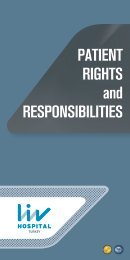MEN’s HEALTH
You also want an ePaper? Increase the reach of your titles
YUMPU automatically turns print PDFs into web optimized ePapers that Google loves.
<strong>MEN’s</strong> <strong>HEALTH</strong><br />
TURKEY
C<br />
Life is like a game<br />
A struggle to the end...<br />
To keep ahead in this marathon<br />
You need a strong defense<br />
Against sudden attacks and challenges<br />
And your greatest strength in this struggle:<br />
<strong>HEALTH</strong>!
CONTENTS<br />
02<br />
Introduction<br />
16<br />
Health in Ageing<br />
03<br />
Our Lifestyle Determines Our Health<br />
18<br />
Kidney and Urinary Tract Stone Disease<br />
04<br />
Vaccines at Any Age<br />
19<br />
Urinary Incontinence<br />
04<br />
10 Good Habits for a Healthy Life<br />
19<br />
Enlarged Prostate<br />
06<br />
Take Exercise for a Healthy Life<br />
20<br />
Prostate Cancer<br />
07<br />
Nutrition and Diet<br />
21<br />
Bladder Cancer<br />
08<br />
Esthetic Applications<br />
22<br />
Kidney Cancer<br />
10<br />
Stem Cell Applications<br />
23<br />
Testicular Cancer<br />
12<br />
Cosmetic Dermatology Applications<br />
24<br />
Headaches and Migraine<br />
14<br />
Men’s Health<br />
24<br />
Hormonal and Metabolic Diseases<br />
14<br />
14<br />
16<br />
Erectile Dysfunction<br />
Penis Prosthesis Implantation<br />
Reproductive Health and Diseases<br />
25<br />
26<br />
28<br />
29<br />
Varicose Veins<br />
Lower Back and Neck Pain<br />
Cardiac Health<br />
Oral and Dental Health<br />
30<br />
Eye Health<br />
33<br />
Check-up And Healthy Life<br />
34<br />
Healthy Living Programs (Check-Up)
Thanks to recent medical advances in diagnosis and<br />
treatment, disease can be detected early and even prevented<br />
before it arises. Men face higher risks in certain areas of health,<br />
particularly when it comes to hypertension (high blood pressure),<br />
diabetes, cardiac and coronary diseases. The most crucial<br />
element in maintaining a healthy life is regular check-ups… You<br />
should not skip a check-up even if you feel in good health.<br />
Increase your quality of life, take early precautionary measures<br />
against diseases to which you may be genetically predisposed,<br />
and get the full flavor of a truly healthy life…
03 | <strong>MEN’s</strong> <strong>HEALTH</strong><br />
OUR LIFESTYLE DETERMINES<br />
OUR <strong>HEALTH</strong><br />
PREVENTION IS BETTER<br />
THAN CURE<br />
The foundations of your future life are laid the moment<br />
you are born. Unless you are an identical twin, you will<br />
inherit your parents’ genes in a totally unique way unlike<br />
any other human being. This genetic makeup helps to<br />
determine who you are, how you look, your bodily structure<br />
and what diseases you may be susceptible to. Environmental<br />
factors from fetus to cradle to grave not only<br />
affect your health but also determine diseases and illnesses<br />
from which you may suffer. Yet however important<br />
genetic and environmental factors may be, lifestyle remains<br />
one of the most significant determinants of a person’s<br />
health and wellbeing, for good or ill.<br />
The great majority of men only undergo a urologic examination<br />
when they actually encounter a health issue.<br />
However, a number of serious complaints including<br />
prostate disorders, bladder cancer and erectile dysfunction<br />
can be treated with early diagnosis.<br />
START PRECAUTIONARY<br />
MEASURES AT AN EARLY AGE<br />
The risk of certain diseases such as cancer and heart disease<br />
increases with age. But not all disease risks are age-related.<br />
For this reason, protective and preventative measures<br />
should be started at an early age.<br />
DON’T SKIP<br />
CHECK-UPS<br />
Recommended health check-ups and screening tests<br />
should start after the age of 21 and continue throughout<br />
your life. You might feel fit and healthy in your 20’s, but<br />
many diseases and health issues can be prevented at that<br />
age or treated more effectively upon an early diagnosis.<br />
MAKE BIG CHANGES<br />
IN SMALL STEPS<br />
Regardless of your age and condition, the best way to<br />
minimize risks to your health and prevent the future<br />
problems arising is to develop healthy habits. Taking small<br />
steps towards a healthy life is better than doing nothing.<br />
It is never too late to start.
VACCINES AT ANY AGE<br />
Vaccinations and inoculations are not just for children, they can<br />
protect people of all ages from dangerous and fatal diseases.<br />
Whatever your age, do you know what vaccinations you should<br />
be having? Adults should also ask about vaccinations, which are<br />
a crucial element in preventive medicine, and should remember<br />
the significance they play.<br />
Tdap (Combined Tetanus, Diphtheria and Pertussis Vaccine):<br />
If this has not been carried out before, a single booster jab is<br />
administered.<br />
Td (Tetanus – Diphtheria): 1 dose is repeated every 10 years.<br />
Protection from tetanus (which can be caught from injuries from<br />
rusty or dirty implements) and diphtheria is important.<br />
HPV (Human Papillomavirus): This is recommended for girls<br />
and boys between the ages of 11 and 12; vaccination concludes<br />
between 13 and 26. It is recommended up to the age of 46. It<br />
plays a significant role in preventing cervical cancer, anal cancer<br />
and genital warts in men.<br />
Seasonal Influenza Vaccine (Flu Jab): This is advised once every<br />
year.<br />
Varicella (Chickenpox): This can be carried out at any age; 2<br />
doses are sufficient for a lifetime.<br />
MMR (Measles – Mumps – Rubella): In the event that lab tests<br />
reveal no previous infection or immunity, 1 dose is administered<br />
or 2 doses in exceptional circumstances.<br />
Hepatitis A: This is advised if certain risk factors are present. (It<br />
is part of the vaccine program of the Turkish Ministry of Health<br />
and many others worldwide, recommended in combination with<br />
immune testing).<br />
Meningitis Vaccine (Meningococcal): It is advised for students<br />
staying in dormitories, soldiers, those with occupational exposure<br />
and those travelling to affected regions (it is obligatory for<br />
those attending the pilgrimage to Mecca).<br />
Pneumonia Vaccine (Pneumococcal): Recommended for<br />
certain high risk groups.<br />
10 GOOD HABITS FOR<br />
A <strong>HEALTH</strong>Y LIFE<br />
You should try to develop the best possible health habits<br />
in your 20’s. This will help you to build the foundations for<br />
a later healthy life lived to the full.<br />
1. Eat a balanced diet: consume 5 portions of fruit and<br />
vegetables a day.<br />
2. Maintain a healthy weight, take exercise and physical<br />
activities.<br />
3. Give up smoking: if you feel you need help, join a<br />
support group or speak with your doctor.<br />
4. Drink responsibly: limit your alcohol consumption.<br />
5. Drive carefully: Traffic accidents are a leading cause of<br />
death.<br />
6. Get a good night’s sleep: lack of sleep affects your<br />
mood, productivity, relationships and safety.<br />
7. Maintain a healthy sex life.<br />
8. Brush and floss your teeth regularly. Good dental hygiene<br />
does not just mean clean teeth but protects your<br />
general state of health.<br />
9. Drink 2 – 2½ liters of water a day.<br />
10. Protect yourself from the UV rays of the sun: use sun<br />
lotions and wear sunglasses.
05 | <strong>MEN’s</strong> <strong>HEALTH</strong>
<strong>MEN’s</strong> <strong>HEALTH</strong><br />
TAKE EXERCISE<br />
TO KEEP <strong>HEALTH</strong>Y<br />
Sağlıklı yaşamın temel şartlarından biri hareket etmek!<br />
One Düzenli of the egzersiz basic conditions yaparak enerjimizi of good health yükseltebilir, is simply stresle moving around! Taking regular exercise increases<br />
our savaşabilir, energy, combats uyku kalitemizi stress, and artırabiliriz. increases Bütün the quality bunlar of sleep. Keeping a healthy body structure<br />
protects sağlıklı bir us from vücut all yapısına kinds of sahip weight-related olmamızı ve diseases fazla kiloya and conditions.<br />
Taking bağlı hastalıklara exercise and karşı playing bizi koruyacaktır.<br />
sports can help to avoid or overcome health problems such as cardiac and<br />
coronary Spor yaparak diseases, kalp-damar diabetes, blood hastalıkları, pressure şeker issues hastalığı, and cancer. It also avoids excess weight and helps us<br />
to tansiyon, have athletic kanser gibi body. hastalıkların önüne geçebilir, fazla<br />
kilolardan arınabilir ve daha atletik bir vücuda sahip<br />
olabilirsiniz.<br />
TAKE 10,000 STEPS A DAY<br />
Get a pedometer and count the number of steps you take<br />
in a day. The average length of a single step is 50-75 cms.<br />
If you have a sedentary occupation, you can walk the<br />
equivalent distance of at least 2000 paces; keep an eye on<br />
your pedometer as a source of motivation in keeping to<br />
your target.<br />
Get on the bus one stop ahead every morning.<br />
Use the stairs rather than the lift.<br />
Park as far away as possible from your destination.<br />
Walk to speak to your work colleagues face to face rather<br />
than using the phone for internal calls.
07| <strong>MEN’s</strong> <strong>HEALTH</strong><br />
HOW MUCH EXERCISE SHOULD I TAKE?<br />
ARE YOU TAKING ENOUGH<br />
EXERCISE?<br />
You should walk at least 10,000 paces every day. In addition,<br />
you should aim to take 30 minutes of medium intensity<br />
physical exercise five times a week, or aerobic exercises<br />
three times a week. As long as your heart rate increases,<br />
it does not matter what kind of exercise you are<br />
doing. Choose a form of exercise that you enjoy, be it<br />
joining a dance club or going swimming. Try to get up early<br />
and take exercise. Set yourself targets like joining fun<br />
runs; this will help maintain your level of motivation.<br />
If taking exercise is as easy as you say, it means you are<br />
not pushing yourself enough. And if you are always out of<br />
breath, it means you are pushing yourself too hard. The<br />
right place is somewhere between these two points. You<br />
might think that to start with you are pushing yourself<br />
hard enough by taking a brisk walk. But as you become<br />
fitter you will need to increase the level of exercise. Get a<br />
heart rate monitor and aim for a maximum heart rate<br />
increase of 75-85% during exercise.<br />
NUTRITION<br />
AND DIET<br />
Nutrition is closely related to your condition of health and its maintenance throughout your life. As a step towards a healthy life<br />
you should determine a nutrition program in line with yourself, your lifestyle and your body type. Instead of over-ambitious<br />
targets, set yourself attainable objectives. Ignore magic formulae and miracle diets.<br />
There is no single diet that works for everyone. Everyone has to have a nutrition program that is unique to him or her. Our metabolisms<br />
and lifestyles are as unique as our fingerprints. It is important to follow a diet that does not deprive of your favorite<br />
foods. Your diet should include appropriate quantities of all the main food groups. The important thing is not what you eat, but<br />
when and how much.<br />
Contrary to what many of us believe, dieting is not only about losing weight. Following a “Healthy Eating Program” designed by<br />
our expert dieticians and nutritionists also improves your quality of life.
<strong>MEN’s</strong> <strong>HEALTH</strong><br />
ESTHETIC<br />
(COSMETIC)<br />
APPLICATIONS<br />
These days, men as well as women have esthetic applications or cosmetic surgery. Nowadays men<br />
do not just use anti-aging pills and face creams but also hair implantations, penis enlargements,<br />
liposuction of the jowls and abdomen and similar applications. Indeed according to<br />
the latest statistics, these are amongst the most common reasons for men to go the<br />
doctor. Nowadays 14% of botox applications, 8% of liposuction applications and 24%<br />
of hair removal treatments are carried out on men. 11% of non-surgical face and<br />
body lifts are carried out on men. Mengenerally want to appear younger and<br />
are often keen to lift sagging eyelids and faces.The number of men seeking<br />
gynecomastia, or surgical chest expansion, is also growing.<br />
NASAL COSMETIC SURGERY<br />
(RHINOPLASTY)<br />
Esthetically, the nose is the most important part of the<br />
face and should have a natural appearance. Cosmetic<br />
surgery designed to give shape to the nose can alter the<br />
form of the nasal bone or the tip of the nose, can shrink or<br />
enlarge the nose, and make the nostrils smaller. Other<br />
problems that can affect sound breathing such as polyps,<br />
sinusitis, nasal flesh and deviated septum may also be<br />
addressed by surgical means.<br />
There are 3 types of nasal surgery:<br />
Primary Rhinoplasty: This is the initialcosmetic operation.<br />
The surgery may be carried out using open or closed<br />
surgical techniques depending on the surgeon’s preference.<br />
The post-op use of tampons has been greatly diminished.<br />
A nasal splint is kept in place for a period of 8 days.<br />
Secondary Rhinoplasty: In the event that the surgeon or<br />
patient is not satisfied with the results of the initial<br />
surgery, or if there are functional issues, it may be repeated<br />
once or more.<br />
Nasal Reconstruction: This is an operation that addresses<br />
functional rather than cosmetic issues related to<br />
causes such as accident injuries, cancer or cocaine use.<br />
These operations often require the transfer of tissue and<br />
cartilage to the nose from adjacent or distant areas.<br />
HAIR LOSS AND TREATMENT<br />
Normal hair loss involves the loss of 80 – 100 strands of<br />
hair every day. More than that is excessive and requires<br />
treatment. If medical treatment cannot address the<br />
condition, surgical methods of hair implantation / transplantation<br />
are applied. Hair follicles programmed not to be<br />
lost are taken from the area above the neck between the<br />
ears and transplanted to the area of hair loss.<br />
FOLLICULAR UNIT<br />
EXTRACTION (FUE)<br />
In the FUE method, hair follicles are extracted from the<br />
neck area or other parts of the body using a special device<br />
and implanted into the area of hair loss or thinning with<br />
specially designed thin tipped needles. Since there are no<br />
stitches above the neck, the procedure leaves no surgical<br />
scar.
09 | <strong>MEN’s</strong> <strong>HEALTH</strong><br />
en<br />
e-<br />
to<br />
he<br />
%<br />
nd<br />
nd<br />
ing<br />
GYNECOMASTIA<br />
Gynecomastia means the excessive growth of breast<br />
tissue in males. While it does not pose a physical health<br />
problem, in rare cases it can result in discomfort and<br />
psychological distress that represents a threat to the<br />
patient’s health. Gynecomastia can limit a person’s physical<br />
activities and the kind of clothes that the patient is<br />
able to wear.<br />
There are three surgical methods of gynecomastia<br />
treatment:<br />
1. Excisional (tissue removal) method:<br />
A half crescent excision is made round the edge of the<br />
dark pigmented area at the center of the breast, and<br />
excess tissue is surgically removed. Just as with the other<br />
methods, satisfying results are achieved with a recovery<br />
period of a few days.<br />
2. Liposuction:<br />
Excess breast material is evacuated by means of thin<br />
pipes placed into the tissue via 1-2 mm incisions. This<br />
method is effective in cases where there is an excess of<br />
mainly fatty tissue. But ultrasonic and laser liposuction<br />
methods can effectively be carried out on all types of<br />
breast tissue with high success rates. A millimetric<br />
unnoticeable scar is left. The procedure is conducted under<br />
local anesthetic and requires no hospitalization. The<br />
recovery period is much shorter and more comfortable.<br />
3. Combined liposuction and excisional method:<br />
Some cases may require the combined use of both<br />
methods.<br />
LIPOSUCTION<br />
Sedentary lifestyles and consequent weight gain is a<br />
leadingproblem of contemporary life. These days, men as<br />
well as women want to look fit and healthy. Liposuction<br />
involves the removal of fat that has accumulated in<br />
certain parts of the body (hips, buttocks, waist and belly)<br />
by vacuum using a cannula via a tiny incision. Liposuction<br />
is not a weight loss method; it is a surgical method to<br />
correct and shape the body. The procedure is carried out<br />
local anesthetic, occasionally under general anesthetic.<br />
The patient is discharged the same day and the number of<br />
people who have had liposuction procedures is increasing<br />
in line with technological advances. A corset may need to<br />
be worn for a period of 6 weeks after the procedure.
STEM CELL /<br />
GENETIC APPLICATIONS<br />
COSMETIC SURGERY<br />
AND STEM CELL TREATMENT<br />
The use of regenerative cells obtained from the patient<br />
himself has cosmetic applications as well. This allows the<br />
renewal of the skin and other regions that show signs of<br />
ageing. This treatment is administered in three stages.<br />
First, fatty tissue is extracted by liposuction or biopsy<br />
methods. The regenerative cells obtained are refined and<br />
concentrated by various methods. The regenerative cells<br />
are then injected into the appropriate area according to<br />
the patient’s requirements, either by themselves or in the<br />
form of a natural cocktail.<br />
FACIAL AND BODY FILLING<br />
(ANTI-AGING)<br />
Fillings using non-natural products such as implants are<br />
subject to a reabsorption rate of up to 70%. Filling that<br />
uses regenerative cells from the patient’s own body has a<br />
far better appearance than fillings that use artificial<br />
means. Rather than having to have continuous repeat<br />
operations, a one-time injection is sufficient.
11 | <strong>MEN’s</strong> <strong>HEALTH</strong><br />
PERSONAL / PREVENTIVE MEDICINE<br />
GENETIC RISK ANALYSIS<br />
LIMB ISCHEMIA<br />
Genetic science has created the possibility of personalized<br />
(individualized) treatment methods.Diseases diagnosed<br />
at the Liv Hospital Individualized Treatment and Preventive<br />
Medicine Departments can be treated using individualized<br />
procedures after detailed DNA analysis has been<br />
conducted. The patient’s DNA is extracted to produce his<br />
personal unique “Health ID”; if any disease is detected, the<br />
patient is provided with an individualized treatment<br />
program at our Individualized Treatment Department. If<br />
risk analysis indicates a risk of disease in the patient’s<br />
Health ID (that is, if the patient runs a high risk of suffering<br />
from certain disease in the future), disease determination<br />
and precautionary treatment may be carried out at<br />
the Department of Preventive Medicine.<br />
As well as helping to address a number of diseases,<br />
regenerative stem cells from the patient’s own body also<br />
allows the treatment of blocked vessels (vascular occlusion).<br />
Medical treatment for this condition includes various<br />
medication, ozone and high pressure treatments. Surgical<br />
methods involve amputation as a last resort, or sympathectomy<br />
(removal of sympathetic nerves). State of the art<br />
medical treatment involves the application of regenerative<br />
stem cells to close the wound and restore circulation.<br />
ORTHOPEDIC BIOLOGIC /<br />
STEM CELL TREATMENTS<br />
CARTILAGE AND<br />
DEGENERATIVE JOINT DISEASE<br />
Cartilage problems<br />
Tendon injuries and tendinitis / tendinosis issues<br />
Joint degeneration applications<br />
Spinal problems<br />
Sports injuries, in particular soft tissue problems<br />
Stem cell applications play an important role in orthopedic<br />
treatment, especially the treatment of cartilage conditions.<br />
Regenerative cells obtained from the patient’s own<br />
tissue by biopsy can result in the formation of cartilage<br />
even in areas from where the cartilage has almost entirely<br />
disappeared. This enables the functional and structural<br />
renewal in the joint area.
COSMETIC DERMATOLOGIC<br />
APPLICATIONS<br />
HAIR<br />
LASER TREATMENT<br />
The most common form of hair loss in men is genetic hair<br />
loss. This type of hair loss begins a person’s 20’s and can<br />
continue into his 40’s. Externally applied medications<br />
applied to the hair at the early stages of hair loss can<br />
reduce the rate of loss. Mesotherapy and PRP treatments<br />
can significantly slow the rate of loss. However, genetic<br />
hair loss will continue to occur in spite of the application of<br />
such treatments. In such cases surgical hair loss<br />
treatment may be considered. In the event that hair loss<br />
continues in spite of medical treatment, hair implantation<br />
may be the preferred option.<br />
Targeted laser treatment is used for treatment of a highly<br />
sensitive area. Laser treatment may eradicate brown<br />
marks or spots on the skin, or remove visible or burst blood<br />
vessels. Dermatological use of laser treatment has greatly<br />
increased in recent years, with successful results. Laser<br />
treatment is used for skin rejuvenation, skin pore tightening,<br />
spot treatments and the treatment of vascular<br />
issues. The application of laser beams to the skin causes a<br />
certain level of heat under the skin and regenerates<br />
collagen. This gives the skin a young, glowing and taut<br />
appearance. Laser treatment can also be used to eradicate<br />
acne scars.<br />
BOTOX<br />
These days, men and women both want to have young and healthy looking skin. Wrinkles are<br />
categorized as facial movement wrinkles (on the forehead and around the eyes), or wrinkles<br />
caused by gravity and sagging skin (the folds of the skin around the mouth). Different methods<br />
are applied according to the type and location of wrinkles. Botox and filling, which eradicate or<br />
limit indications of aging, can be applied at any age.
13 | <strong>MEN’s</strong> <strong>HEALTH</strong><br />
MESOTHERAPY<br />
This is a frequently used treatment for wrinkles, skin<br />
blemishes and loss of skin tone. Mesotherapy is used to<br />
give the skin in the affected area a vibrant and attractive<br />
appearance. Vitamin and mineral mixtures can be injected<br />
into any affected area of the body using a thin needle. In<br />
time this leads to a healthy looking facial appearance, with<br />
the skin taking on a more glowing and lively appearance.<br />
CHEMICAL PEELING<br />
PRP<br />
(PLATELET RICH PLASMA)<br />
Used as a treatment method in various areas including<br />
skin rejuvenation, hair loss, scar removal, and the<br />
treatment of acne scars and surgical scars, PRP treatment<br />
involves the injection of concentrated platelets obtained<br />
from the patient himself, often using ultrasound for<br />
accuracy. The “growth factors” that the platelets secrete<br />
stimulate tissue recovery by increasing collagen production,<br />
enhancing tendon stem cell proliferation, and tenocyte-related<br />
gene and protein expression. These growth<br />
factors also stimulate blood flow and cause cartilage to<br />
become more firm and resilient. PRP activates tenocytes<br />
to proliferate quickly and produce collagen to repair injured<br />
tendons, ligaments, cartilage, and muscles.This process<br />
greatly boosts the healing process.<br />
The upper layer of skin that has become worn, or that has<br />
lost its freshness and brightness, is peeled away, while the<br />
lower layer begins a process of restructuring. This achieves<br />
an even appearance of more youthful and healthy skin.<br />
Following skin peeling the skin will have an unblemished<br />
and smooth appearance. Wrinkling is reduced and skin<br />
coloring will be more evenly spread.<br />
MICRODERMABRASION<br />
Microdermabrasion applies very tiny rough grains of<br />
crystals, diamonds and bristle tips to peel off the outermost<br />
surface of the skin. Applied over a period of 2 to 4<br />
weeks over a number of sessions, it gives the skin a youthful<br />
appearance.
<strong>MEN’s</strong> <strong>HEALTH</strong> CLINIC<br />
Devoted to the maintenance of male reproductive and<br />
sexual health, the Liv Hospital Men’s Health Clinic deals<br />
with sexual dysfunction, reproductive issues, sterility,<br />
STD’s, and prostate diseases that generally occur in men<br />
after the age of 50.<br />
ERECTILE DYSFUNCTION<br />
More than 90% of erectile dysfunction issues are related<br />
to an underlying organic disorder.Diabetes, coronary artery<br />
disease, high blood pressure, arteriosclerosis, high cholesterol,<br />
obesity, smoking, spinal cord injury, prostate disease<br />
and prostate cancer treatments, thyroid disease, decreases<br />
in testosterone levels and certain surgical procedures<br />
can all lead to erectile dysfunction. Erectile dysfunction<br />
can be treated at all ages. The Liv Hospital Men’s Health<br />
Clinic treats cases of erectile dysfunction, premature<br />
ejaculation, and curvature of the penis using state of the<br />
art technology and methods.<br />
Comprehensive Check-Ups<br />
Are Essential<br />
Patients with coronary disease or diabetes are at high risk<br />
of suffering erectile dysfunction. Our Urology Department<br />
may therefore examine patients with this condition for<br />
conditions such as diabetes, cardiac – coronary disease,<br />
high blood pressure, and high cholesterol levels. Patients<br />
with enlarged prostates or at risk of prostate cancer are<br />
given a comprehensive check-up. In addition, patients are<br />
examined for endocrine disorders related to their general<br />
condition, cardiac – coronary disease and principally diabetes.<br />
Erectile dysfunction patients are comprehensively<br />
examined by physicians and specialists from the departments<br />
of Urology, Cardiology and Endocrinology.<br />
Shock Wave Treatment<br />
Shock wave treatment is carried out for erectile dysfunction<br />
at our Urology Department, with excellent results. This<br />
treatment offers a lasting solution to erectile dysfunction<br />
especially for cardiovascular disorder-related cases. This<br />
treatment offers positive outcomes for patients who do<br />
not wish to take medication, who have responded to<br />
medical treatment but do not wish to take further<br />
medication, those who have not responded well to<br />
medical treatment, or those who wish to delay surgical<br />
treatment.
15 | <strong>MEN’s</strong> <strong>HEALTH</strong><br />
PENILE IMPLANTS<br />
Following penile Doppler ultrasound evaluation, patients<br />
who have not responded to oral medication, shock wave<br />
and injection treatments, and patients with severe cardiovascular<br />
disease, may be suitable candidates for penile<br />
implants. A flexible, concealed, inflatable prosthesis is<br />
chosen on the basis of the patient’s preference and the<br />
nature of his underlying condition. Three-piece inflatable<br />
prostheses are generally preferred as they facilitate an<br />
actual erection as well as for cosmetic reasons. Penile<br />
prosthesis surgery is conducted under close monitoring<br />
and follow-up, and with a short period of hospitalization.<br />
The risk of complication has been reduced with technological<br />
improvements and antibiotic-coated implants.<br />
5 GOLDEN RULES FOR A <strong>HEALTH</strong>Y<br />
ERECTION!<br />
DID YOU KNOW…?<br />
About 1 in 3 men over the age of 40 experience erectile<br />
dysfunction. Erectile dysfunction is a treatable condition.<br />
Yet only 5-10% of men with this condition go to a doctor<br />
for help.<br />
While this condition is generally mild or moderate in<br />
severity in younger age groups, it tends to be moderate or<br />
severe in older men. It can be triggered by diabetes, high<br />
cholesterol, hypertension, obesity, and cardiovascular<br />
disorders.<br />
Take regular exercise<br />
Lose excess weight<br />
Give up smoking and limit your alcohol intake<br />
Follow a Mediterranean-type diet<br />
Check your testosterone levels<br />
Erectile dysfunction is a warning sign of cardiovascular<br />
disease.<br />
One of the most important factors in achieving erection is<br />
the testosterone hormone. Testosterone levels begin to<br />
decline in men in their 40’s.
MALE REPRODUCTIVE<br />
<strong>HEALTH</strong> AND DISEASES<br />
<strong>MEN’s</strong> <strong>HEALTH</strong> AND AGING<br />
About 15 out of every 100 couples suffer from infertility<br />
issues. Men and women are affected in roughly equal<br />
proportions. 30-40% of cases are male infertility, 30-40%<br />
female, while 10-20% are cases of male and female<br />
infertility. However in about 10% of cases, the cause of<br />
infertility cannot be discovered. Many cases of male<br />
infertility determined after a detailed evaluation can be<br />
addressed with medication and hormones, or with surgery<br />
Disease-specific Treatment<br />
55% of men in Turkey over the age of 40 show indications<br />
of testosterone deficiency. Testosterone deficiency can<br />
reduce sexual function and libido, leading to erectile<br />
dysfunction, muscle loss and an increase in fatty mass.<br />
This can also be a cause of bone loss (osteoporosis),<br />
memory loss, and an increased susceptibility to diabetes<br />
caused by insulin resistance as well as having an adverse<br />
effect on self-esteem, psychological and cardiac health.<br />
Liv Hospital’s Urology Department conducts detailed<br />
evaluations of men showing signs of erectile dysfunction<br />
and testosterone deficiency, to provide recovery<br />
treatment programs that greatly increase their quality of<br />
life.<br />
Varicocele, one of the leading causes of male infertility, is<br />
corrected at the Liv Hospital Urology Department using<br />
microsurgical methods and techniques (microscopic<br />
varicocelectomy, microsurgical varicocelectomy). Sperm<br />
duct blockages (obstructive azoospermia) can be surgically<br />
unblocked (TUR-ED, vasovasostomy, vasoepididymostomy,<br />
and other means). Men lacking sperm output<br />
(non-obstructive azoospermia) may be treated using<br />
microsurgery to obtain their sperm (micro-TESE) for<br />
subsequent IVF or microinjection (ICSI) procedures. Men<br />
who want to have a vasectomy for contraceptive purposes<br />
can have the procedure rapidly concluded on an out-patient<br />
basis. The freezing of sperm (cryopreservation) can be<br />
carried in certain cases where particular health issues<br />
require it.
17 | <strong>MEN’s</strong> <strong>HEALTH</strong>
KIDNEY AND URINARY<br />
TRACT STONE DISEASE<br />
20% of men and 20% of women suffer some form of<br />
kidney or urinary tract stone disease at some stage in their<br />
lives. While open surgery used to be the favored<br />
treatment, the use of advanced technology and endoscopic<br />
(keyhole) surgery is greatly expanding.<br />
State of the Art Techniques<br />
Liv Hospital’s Urology Department uses closed<br />
(endoscopic or percutaneous) surgery in the treatment of<br />
all kinds of kidney, ureter, bladder and urethra stone. Using<br />
Holmium laser, pneumatic and ultrasound stone breaking<br />
systems, large kidney stones can be cleared by means of<br />
the Percutaneous Nephrolithotomy (PNL) method.<br />
What is Percutaneous<br />
Nephrolithotomy?<br />
A 1 cm pipe or catheter is inserted via a small incision in the<br />
back, through which hi-tech equipment and imaging<br />
systems are used to clear the stones, even if the kidney is<br />
very badly affected and full of stones. If the stones are<br />
smaller in size, a very thin flexible device whose tip can be<br />
controlled by the surgeon (a flexible ureterorenoscopy,<br />
F-URS, RIRC) is inserted through the ureter to reach the<br />
kidney and clear it of stones; laser technology can be used<br />
to break up the stones and clear the kidney. Stones<br />
anywhere in the ureter can be laser-cleared with a semi-rigid<br />
or flexible ureterorenoscope. In cases of bladder<br />
stones, entry is achieved and the stones are cleared either<br />
via the ureter (endoscopic cystolithotomy) or directly by<br />
percutaneous methods (percutaneous cystolithotomy),<br />
depending on the size of the stones.<br />
Thanks to Liv Hospital’s experienced team of physicians<br />
and specialists and its highly advanced technological and<br />
technical infrastructure, we offer minimally invasive<br />
urologic interventions to clear kidney, urinary tract and<br />
bladder stones by means of endourologic techniques that<br />
gain access via the narrow ureter. With close monitoring<br />
and follow-up this facilitates rapid recovery and discharge<br />
from hospital. Most ureteroscopy patients return home on<br />
the same day or the next day, while PNL patients are<br />
generally discharged on the second day after the procedure.
19 | <strong>MEN’s</strong> <strong>HEALTH</strong><br />
URINARY INCONTINENCE<br />
DISORDERS<br />
Urinary incontinence and urinary bladder dysfunction in<br />
men may have a number of causes including enlarged<br />
prostate, chronic urinary bladder infection or nerve<br />
injuries. Patients with permanent urinary incontinence<br />
(that is, patients who have to use diapers on a permanent<br />
basis) can be completely cured of the condition by means<br />
of the application of an artificial sphincter.<br />
ENLARGED PROSTATE<br />
The majority of enlarged prostate cases are benign, or in<br />
medical parlance Benign Prostate Hyperplasia (BPH)<br />
cases. Some cases of enlarged prostate, a condition that<br />
begins after the age of 40, can be partially brought under<br />
control by means of medication; however, about 3 out of<br />
10 men suffering from enlarged prostate-related urinary<br />
incontinence require surgical intervention at some time in<br />
their lives.<br />
Standard Surgical Treatment: TUR-P<br />
Outpatient Treatment: Prostate<br />
Suspension<br />
The Prostate Suspension Method, requiring no anesthetic<br />
or catheter, can be carried out on an outpatient basis. With<br />
pretty well zero complications, this method has gained<br />
significantly in popularity in recent years.<br />
Rapid Recovery with<br />
Laser Treatment<br />
Providing patients with a far greater level of comfort, laser<br />
prostate treatment is now far more widely carried out<br />
than in the past. Liv Hospital’s Urology Department offers<br />
rapid recovery from enlarged prostates of all degrees of<br />
severity using the most advanced laser treatment techniques<br />
and methods.<br />
The standard surgical method for treating enlarged<br />
prostate-related urinary incontinence is the “Transurethral<br />
Resection of the prostate” method, or TUR-P. As well as<br />
standard TUR-P, bipolar devices can be used to perform<br />
the surgery as a way of eradicating prostate-related<br />
urinary problems and reducing complications to a<br />
minimum.
PROSTATE CANCER<br />
One of the most common forms of cancer in men, the<br />
disease is brought on with age. Recent research has revealed<br />
that the development and advance of prostate cancer<br />
is related to molecular, genetic, environmental and nutritional<br />
factors, but the exact cause remains unknown.<br />
Early Diagnosis Saves Lives<br />
The purpose of prostate cancer screening is to catch the<br />
disease while it is still restricted to the prostate organ<br />
itself. The survival rate for early diagnosed cases has risen<br />
from 67% to above 90% in the past 10-20 years. The<br />
10-year survival rate for cases where the disease is spotted<br />
before it has spread beyond the organ is close to 100%.<br />
There are a number of effective treatment methods.<br />
Keyhole and robotic prostatectomy surgery is an option in<br />
early diagnosed cases. For these reasons, the disease<br />
needs to be detected as early as possible.<br />
Annual PSA tests<br />
People with a family history of prostate cancer are at<br />
higher risk of the disease and require regular screening<br />
from the age of 40. Even though scanning is generally<br />
recommended from the age of 45, it is very important to<br />
have a PSA test at the age of 40 with respect to getting a<br />
proper screening and follow-up plan. Men should undergo<br />
annual PSA testing and prostate examination, especially<br />
those with a family history of the disease.
21 | <strong>MEN’s</strong> <strong>HEALTH</strong><br />
SYMPTOMS<br />
Frequent need to urinate<br />
Having to get up at night to urinate<br />
Poor urination flow<br />
Lower back, hip and thigh pain<br />
Painful ejaculation<br />
Erectile dysfunction<br />
2 screening tests are used in the diagnosis of prostate<br />
cancer. If these tests reveals any abnormalities, a prostate<br />
biopsy may be advised.<br />
1. Blood PSA Test: Men over the age of 45 should have this<br />
test conducted annually. If there is a family history of<br />
prostate cancer these tests should start at the age of 40.<br />
Threshold PSA values should be measured at least once at<br />
the age of 40, risk factors should be assessed and the<br />
regularity of subsequent testing should be determined<br />
accordingly. In the event that PSA values rise above a<br />
certain level, a biopsy may be required.<br />
BLADDER CANCER<br />
Bladder cancer is the most common form of cancer of the<br />
urinary system in both men and women. The main risk factor<br />
is smoking. It is also commonly seen in those who are<br />
occupationally exposed to substances in the paint, metal and<br />
petroleum industry. In addition, some permanent hair dyes<br />
have been shown to contain serious carcinogens. The chief<br />
indications are passing blood in the urine, a burning sensation<br />
while urinating and pains in the bladder region. If the<br />
bladder cancer only exists in the bladder mucosa, treatment<br />
is possible by TUR surgery via the urinary tract, and medication.<br />
If the cancer has spread to the bladder muscles, it may be<br />
necessary to remove the bladder completely together with<br />
radiotherapy and chemotherapy. Liv Hospital’s urology,<br />
radiology, radiation oncology, medical oncology and pathology<br />
clinics work in strict coordination with respect to the<br />
diagnosis and treatment of bladder cancer.<br />
2. Finger Prostate Examination: After the age<br />
of 40, a prostate examination conducted by a<br />
urologist combined with a PSA test will<br />
provide more reliable results. If the<br />
prostate examination indicates<br />
any abnormality, a biopsy may<br />
be carried out even in the<br />
absence of any irregularities<br />
in the PSA test<br />
results.
KIDNEY CANCER<br />
Kidney cancers that originate in the cells of the kidney<br />
itself are severe forms of cancer. It is about 50% more<br />
prevalent in men than in women. While it is more<br />
common in the 60-70 age group it does also occur in<br />
younger people. Research shows about 2-3% of cases are<br />
hereditary. The increased use of advanced techniques of<br />
ultrasonography and computerized tomography has led to<br />
an annual increase in detection rates of 3-4% and the<br />
increased possibility of early diagnosis.<br />
Undetected Growth<br />
The main risk factor in kidney cancer is smoking. Other<br />
proven factors include excess weight and high blood<br />
pressure. Since the kidneys are located at the rear of the<br />
abdomen, in many cases the tumor can grow without<br />
being detected. 50% of kidney cancers are detected by<br />
chance as a result of tests carried out for an unrelated<br />
complaint. The disease may show itself after it has grown<br />
in the form of passing blood in the urine, pain or spreading<br />
to other organs. It may also be associated with symptoms<br />
of weight loss, fever, nausea and weakness.<br />
Multidisciplinary Approach<br />
Surgical intervention upon early diagnosis is of crucial<br />
importance in kidney cancer. Diagnosis may be made on<br />
the basis of the detection of blood in a basic urine test, BT<br />
or MR imaging. At Liv Hospital the appropriate treatment<br />
of diagnosed patients is determined by a Cancer Board<br />
composed of specialists from our urology, medical<br />
oncology and radiology oncology clinics. It may be possible<br />
to treat early diagnosed patients by the removal only of<br />
the kidney tumor itself, by means of robotic keyhole<br />
surgery or direct laparoscopic surgery.
23 | <strong>MEN’s</strong> <strong>HEALTH</strong><br />
TESTICULAR CANCER<br />
Testicular cancer constitutes 1% of all cancers in men. It is<br />
the most common form of cancer in men between the<br />
ages of 15 and 35. There is no known cause of the disease<br />
related to personal habits, lifestyle or activities. The two<br />
main known risk factors are undescended testicles and<br />
patients who have had cancer in the other testicle. The<br />
main symptoms are pain, swelling and hardness of the<br />
testicles. Liv Hospital’s urology, medical oncology, radiation<br />
oncology, pathology and radiology clinics jointly plan<br />
diagnostic tests and treatment in cases of testicular<br />
cancer. While surgical intervention by our highly experienced<br />
surgeons is the favored treatment method in many<br />
cases, some patients may require radio and chemo<br />
therapy.
HEADACHES<br />
AND MIGRAINES<br />
Migraine attacks in men can be shorter in duration and<br />
less nauseous than in women. For this reason men do not<br />
always consider they are having a migraine attack, but<br />
rather a headache triggered by a draft or wind, hunger,<br />
sleeplessness, stress or drinking.<br />
Whereas 1 in 4 women suffer migraine, the rate for men is<br />
1 in 12. Genetic factors play a role in migraine attacks,<br />
which constitute a neurologic disease. There is no rule that<br />
says if one of your parents suffered from migraine<br />
attacks, so will you. A family history increases the risk by<br />
1½ - 2 times. Migraine is treatable. As well as the<br />
latest migraine-specific medications, pain prevention<br />
and migraine cure medication treatments<br />
are offered at the Liv Hospital Migraine<br />
Clinic, as well as injection applications<br />
such as botox.<br />
HORMONAL<br />
AND METABOLIC<br />
DISEASES<br />
Many of our bodily functions are initiated and regulated by<br />
hormones. Hormones are produced in the glands that<br />
form our endocrine system, from where they are carried<br />
into cells and tissues via our blood circulation. The term<br />
“metabolism” is used to describe this complex series of<br />
processes. Hormonal disorders affect various metabolic<br />
processes. Hormonal imbalances in our bodies can lead to<br />
a number of diseases including thyroid diseases, obesity,<br />
diabetes, impotence, sexual dysfunction and osteoporosis.
25 | <strong>MEN’s</strong> <strong>HEALTH</strong><br />
VARICOSE<br />
VEINS<br />
While varicose veins, evidenced by more distinct and<br />
visible veins in the legs, as well as pain, swelling, sensitivity<br />
and the feeling of weightiness in the legs, are more<br />
common in women, they do also occur in men. The condition<br />
is more likely to occur in men with a sedentary<br />
lifestyle, a desk job, who gain weight and do not take<br />
much exercise. Further examination and diagnosis of<br />
patients suffering from varicose veins is done by physical<br />
examination and unobtrusive (Color) Doppler ultrasound<br />
testing. Tests are carried out for vascular disorders in the<br />
first place, and a treatment plan is defined.
LOWER BACK AND<br />
NECK PAIN<br />
NECK PAIN<br />
The most common cause of neck pain is muscular tension<br />
in the neck and the upper part of the back. Widespread<br />
body pain and waking up in the morning feeling tired may<br />
lead to fibromyalgia (soft tissue rheumatism) causing<br />
pain in the neck and upper back. Other common causes of<br />
neck pain are calcification of the spinal joints, spinal bone<br />
disc disorders, herniated disc and narrowing of the discs<br />
and other spinal disorders as well as disorders of the<br />
muscles, ligaments and nerve roots. Injuries to the neck<br />
muscles due to a fall or accident, and injuries or breakages<br />
to the spine bone and joints, are other possible causes.<br />
Other causes may be osteoporosis-related breakdown, as<br />
well as spinal infections and tumors.<br />
Treatment<br />
You should consult with your doctor in the event that you<br />
experience pain or stiffness that lasts more than a few<br />
days, neck pain that extends into your arms, or numbness.<br />
In some cases a diagnosis might be made by means of<br />
neck X-ray, tomography or MR imaging tests, or blood<br />
tests. Treatment will be determined according to the<br />
diagnosis. If no surgery is required, physical treatment,<br />
pain relief medication and muscle relaxants, injections<br />
and manual treatment may be appropriate forms of<br />
treatment. Liv Hospital’s Physical Treatment and Rehabilitation<br />
Center carries out various treatment methods<br />
aimed at overcoming pain, resolving muscular spasms,<br />
strengthening the neck and back muscles and achieving<br />
correct posture.<br />
Stronger Neck Muscles<br />
The main causes of these kinds of muscular tensions are mistakes we<br />
make in our daily activities such as sitting in a bad position while at our<br />
desks, watching TV or reading, having our computer screen positioned<br />
too high or low, or sleeping in an uncomfortable position. In order to<br />
prevent neck pain it is important to take neck muscle tension and<br />
strengthening exercises.
27 | <strong>MEN’s</strong> <strong>HEALTH</strong><br />
LOWER BACK PAIN<br />
The most common causes of lower back pain are sitting in<br />
a bad position, lifting heavy objects, standing for a prolonged<br />
period or working in a sedentary position, thus<br />
creating tension in the back muscles. Ruptured or torn<br />
discs, slippage in the bones of the spine, joint arthritis,<br />
breakages due to falls or accident, osteoporosis-related<br />
collapse, infection and tumors can all lead to back pain.<br />
Treatment<br />
Treatment is determined according to the underlying<br />
cause of the pain. If the patient does not require surgery,<br />
conservative treatments such as physical treatment, back<br />
and abdominal exercises, injections and manual<br />
treatment may be implemented. The Liv Hospital Physical<br />
Treatment and Rehabilitation Center provides various<br />
kinds of treatment designed to reduce pain, overcome<br />
muscle spasm, strengthen the back, abdominal and pelvic<br />
muscles, and to give advice on correct posture. Regular<br />
exercise and physical activity is recommended in order to<br />
prevent back pain. Yoga, pilates and swimming are among<br />
the activities recommended for strong abdominal muscles<br />
and to remove excessive stresses and tension in the lower<br />
back.
CARDIAC <strong>HEALTH</strong><br />
Cardiovascular disease is one of the most common health<br />
problems. It is more common in men than in women<br />
pre-menopausal women. Risk factors include a family<br />
history of heart disease, being male, smoking, high blood<br />
pressure, diabetes, high cholesterol and stress. Therefore<br />
it is important to identify and if possible to eradicate the<br />
risk factors that apply to the individual patient. While<br />
factors such as family history and gender cannot be<br />
changed, other factors like smoking, high cholesterol and<br />
high blood pressure can. Some cases do not involve these<br />
risk factors at all; a proper diet and regular exercise can<br />
reduce the risk of heart disease in these patients.
29 | <strong>MEN’s</strong> <strong>HEALTH</strong><br />
DISCOVER YOUR CARDIOVASCULAR AGE<br />
You can find out your state of vascular health and your vascular age<br />
before cardiovascular disease develops. This can be achieved by<br />
methods such as establishing your coronary calcium score (a measurement<br />
of the amount of calcification in your heart vessels), measuring<br />
your carotid intima-media thickness (by ultrasonic measurement<br />
of the thickness of the layers of veins in the carotid artery), and taking<br />
preventive measures. Protecting your blood vessels not only prevents<br />
heart disease but also the development of disease in all the other<br />
blood vessels in your body. For example, diseases such as occlusion of<br />
the cerebral blood vessels, strokes, blockage in the vessels of the<br />
kidney, kidney failure and erectile dysfunction…<br />
ORAL AND DENTAL<br />
<strong>HEALTH</strong><br />
A mouth and teeth in good condition are the most important<br />
indication of overall good health. At every stage of life from<br />
childhood to old age, there are special individualized treatment<br />
methods available for every aspect of oral and dental health. Early<br />
diagnosis and treatment can address every issue from the most<br />
common oral diseases to oral injuries that can develop into mouth<br />
cancer. State of the art microscopic endodontic methods mean<br />
that patients with conditions requiring root canal treatment no<br />
longer have to endure nightmares. And it is now possible to achieve<br />
excellent health and cosmetic outcomes in gum disease<br />
treatment and dental whitening procedures using periodontology<br />
laser technology. Orthodontic treatments facilitate an esthetic<br />
and healthy appearance without using braces or brackets due to<br />
the plaque that adheres to the teeth.
EYE <strong>HEALTH</strong><br />
Liv Hospital offer comprehensive eye health services from<br />
cataract operations to refractive surgery, from treatment<br />
for keratoconus disease to cosmetic procedures in the<br />
region around the eye.<br />
DRY EYE TREATMENT<br />
CORNEA<br />
Tear deficiency, commonly called “dry eye syndrome,” has become a<br />
major issue in the field of disorders and diseases of the eye over<br />
the past 15 years. Dry eye syndrome is not merely a tear deficiency<br />
but can be a cause of various eye problems including ones with<br />
complex pathologies that affect the eyelid and indeed the entire<br />
ocular surface. The underlying cause of dry eye syndrome needs to<br />
be thoroughly investigated in order to establish whether it is ocular<br />
or systemic.<br />
The cornea is the transparent front part of the eye that<br />
covers the iris and pupil. It is the eye’s most important<br />
lens. Diseases of the cornea, from the simplest to the<br />
most complex, have a negative affect both in terms of<br />
vision and cosmetically. Many parts of the corneallayers<br />
are composed of specialized cells. Therefore, cornea disease-related<br />
loss of vision can be permanent. The diagnosis<br />
and treatment of cornea disease is important in terms of<br />
overall eye health.<br />
RETINA<br />
The retina is the tissue at the back of the eye that facilitates sight.<br />
At birth, the retina is attached to the vitreous. Over time the retina<br />
detaches from the vitreous. In 1% of cases this can result in a torn<br />
retina. In the bright sunshine of summer time, retinal detachment<br />
occurs more frequently. With early diagnosis, retinal tears can be<br />
repaired using laser treatment. The most significant symptoms of<br />
retinal tears and detachment are flashes of light and the sudden<br />
appearance floating objects in the field of vision. Early stage laser<br />
treatments can prevent the development of retinal detachment.<br />
Advanced Treatment Methods<br />
Just as diseases of the cornea can only originate in the<br />
corneal layers, all diseases in other parts of the body can<br />
have a negative impact on the cornea. As well as medical<br />
treatment, diseases of the cornea can sometimes be<br />
treated by means of laser treatment or cornea transplant.<br />
A cornea transplant is an operation that changes all or part<br />
of the cornea tissue. Whereas changing the entire cornea<br />
used to be the only option, thanks to advances in medical<br />
technology nowadays it is possible only to change the part<br />
of the cornea that is affected by the disease.
31 | <strong>MEN’s</strong> <strong>HEALTH</strong>
PRESBYOPIA<br />
EYE <strong>HEALTH</strong><br />
Presbyopia is an increasing inability of the eye to focus on<br />
near objects. It generally starts after a person’s 40’s and<br />
progresses gradually. Its main cause is a reduction in the<br />
adjustment capacity of the lens. Farsightedness emerges<br />
earlier and is more pronounced. It can be treated with<br />
glasses, contact lenses, laser treatment or implants.<br />
KERATOCONUS<br />
CATARACTS<br />
Keratoconus is a condition in which your eye's cornea is<br />
unable to hold its round shape, indicated by short sight<br />
and astigmatism. As the condition progresses it affects<br />
vision to the extent that wearing glasses is not a sufficient<br />
remedy. While this condition frequently used to<br />
require a cornea transplant (this was the cause of half of<br />
cornea transplants), advanced methods in use today<br />
facilitate the halting of the condition (cornea collagen<br />
cross-linking) and improving vision to various degrees<br />
(laser, ICRS, RGP lenses).<br />
Cataracts limit vision by thickening the lens of the eye.<br />
Most cases are age-related but some may be caused by<br />
other diseases of the eye. The solution to cataracts is<br />
surgery; the latest early stage surgery involves a small<br />
incision to restore clear vision while intraocular lenses have<br />
been developed to enable close and distant vision. The<br />
permanence of the improved vision that is achieved after<br />
surgery depends on the standard of quality of the equipment<br />
and the intraocular lenses that are used. In the past<br />
one or two years cataract surgery has been improved with<br />
the introduction of femtosecond laser cataract surgical<br />
techniques that have also improved the safety of the<br />
procedure.<br />
REFRACTIVE SURGERY<br />
Refractive surgery began as a way to correct refractive<br />
errors. While it used to aim at releasing people from the<br />
need to wear glasses, it now aims to produce better<br />
results than could be achieved with glasses. This is the<br />
“Wavefront” method that can correct disorders that<br />
affect vision but are too small to measure with standard<br />
equipment. Alternatives in cases that are not amenable to<br />
laser correction include intraocular lens and clear lens<br />
surgery.
33 | <strong>MEN’s</strong> <strong>HEALTH</strong><br />
CHECK-UP AND<br />
<strong>HEALTH</strong>Y LIFE<br />
WHOLE BODY MRI CHECK-UP<br />
You whole body can be scanner in 45 minutes without any<br />
radiation exposure and adverse effect by Whole Body MRI,<br />
and it provides to detect tumors and tumor-like lesions<br />
that are generally bigger than 1 cm. Whole Body MRI<br />
provides its detection in early stage where treatment<br />
change is highest before emergence of the disease.<br />
“Whole Body MRI”, is used together with classic scanning<br />
methods in order to detect possible tumors in early stage,<br />
is offered to the patient who has cancer risk or concern<br />
and receive Check-up for this concern as alternative and<br />
highly developed Check-up model. Another advantage of<br />
Whole Body MRI is to provide scanning of the areas such<br />
as brain tissue, bone structure and extremity in single<br />
time, which is not generally included in Check-up examinations,<br />
besides scanning of intra abdomen and lungs, which<br />
are scanned with classic radiology Check-up methods.<br />
Content of Whole Body MRI Check-up<br />
• Check-up Examination<br />
• Whole Body MRI<br />
THORAX CT – VIRTUAL ANGIOGRAPHY<br />
(CT CORONARY ANGIOGRAPHY)<br />
CHECK-UP<br />
This method, visualizing flow of the contrast agent that is<br />
administered intravenously from arm through the veins as<br />
tomographical, gives crucial information about both<br />
identifying coronary artery occlusion and arteriosclerosis<br />
presence (arterial hardening). If no occlusion is detected in<br />
coronary arteries, diagnosis assures nearly 100 per cent<br />
rate. Classic Angiography is performed to visualized<br />
cardiac veins through arm and leg arteries by administrating<br />
contrast agent from a catheter. Diagnosis of coronary<br />
artery diseases has 100 per cent accuracy by using this<br />
method.<br />
Procedure preparations last between 30 minutes and 1<br />
hour. Inpatient or outpatient recovery is recommended to<br />
the patient for 24 hour in post-operation according to<br />
localization of vein. In Virtual Angiography; contrast agent<br />
is directly administered from arm vein and arteries and<br />
veins are visualized as tomographical. Procedure is performed<br />
in 10 seconds and it provides equal diagnostic<br />
accuracy with classic angiography if arteries and veins are<br />
found normal. Contrast agent is similar in both methods,<br />
and radiation exposure is generally less than classic<br />
angiography.<br />
Content of Thorax CT – Virtual Angiography<br />
(CT Coronary Angiography) Check-up<br />
• Check-up Examination<br />
• Coronary CT Angiography<br />
• Thorax CT
<strong>HEALTH</strong>Y LIVING<br />
PROGRAMS<br />
Health is a person’s most cherished asset. Regular check-ups are needed to have a healthy life and<br />
protect that asset. If you wish to protect yourself from disease and illness, get early diagnosis of<br />
existing conditions, and have a healthier life, you should have a proper check-up at least once a year.<br />
WHY SHOULD YOU<br />
HAVE A CHECK-UP?<br />
• You aim to lead a long and healthy life<br />
• You want to know what needs to be done to achieve this<br />
• You want to look as healthy as you feel<br />
• Your hectic life makes it difficult for you to find time to<br />
devote to your health<br />
• Anything in your family history gives rise to concern<br />
• You want to catch any health issues early, for easier<br />
treatment<br />
<strong>HEALTH</strong>@LIV BASIC PACKAGE<br />
In the basic package, vital systems are subject to general<br />
testing and critical data about their functioning is<br />
obtained. The package includes basic cardiologic, radiologic<br />
and laboratory tests regardless of age or gender. The<br />
systems are evaluated according to main headline criteria.<br />
The results and pathology that emerges from these tests<br />
will give an indication about how to proceed.
35 | <strong>MEN’s</strong> <strong>HEALTH</strong><br />
YOUNG LIV MEN<br />
UP TO THE AGE OF 39<br />
This package focuses on risks and functional capacities of<br />
particular relevance to young men, as well as general<br />
tests. The contents of the test package have been designed<br />
to combine age and gender related variables for the<br />
most useful possible results.<br />
The package includes X-ray and ultrasound imaging,<br />
biochemical, hematological, hormonal and serological<br />
tests, electrophysiological cardiac assessment, and an<br />
overall assessment by physicians including a dentist.<br />
YOUNG-PLUS LIV MEN<br />
(AGE 40-49)<br />
STANDARD LIV MEN<br />
The tests and detailed physical examination included in<br />
this program evaluate metabolic and bodily functions;<br />
important health recommendations are given in the light<br />
of the results of these tests. This is suitable for a general<br />
evaluation for men whose previous tests have not revealed<br />
any particular issue.<br />
The package includes X-ray and ultrasound imaging,<br />
biochemical, hematological, hormonal and serological<br />
tests, electrophysiological cardiac assessment, and an<br />
overall assessment by physicians including a dentist.<br />
This program provides detailed testing for men who are<br />
still young but need to be aware of certain age-related<br />
issues that may affect their health. Tests related to<br />
various branches of medicine are carried out and the<br />
results are evaluated in order to plot an individual road<br />
map for a healthy life.<br />
The package includes X-ray and ultrasound imaging,<br />
biochemical, hematological, hormonal and serological<br />
tests, metabolic profile analysis, electrophysiological and<br />
stress test cardiac assessment, age-appropriate prostate<br />
and hormone tests, mammography, and an overall<br />
assessment by physicians including andrologists and<br />
dental specialists.
36 | <strong>MEN’s</strong> <strong>HEALTH</strong><br />
<strong>HEALTH</strong>Y LIVING<br />
PROGRAMS<br />
ACTIVE LIV MEN<br />
(AGE 50-65)<br />
EXECUTIVE LIV MEN<br />
The Active Liv Men program is designed for men over the<br />
age of 50 who are determined to maintain an active life<br />
but who are aware of the potential threats to health<br />
associated with their age group. While this age group<br />
remains highly active both physically and mentally, special<br />
care and attention is required to ensure the whole body<br />
keeps working in harmony.<br />
The package includes X-ray and multi-site ultrasound<br />
imaging, biochemical, hematological, hormonal and<br />
serological tests, metabolic profile analysis, trace element<br />
and vitamin level tests, electrophysiological and stress<br />
test cardiac assessment, echocardiography, age-appropriate<br />
scan tests, and an overall assessment by physicians<br />
including urologists, cardiologists, ophthalmologists and<br />
dental specialists.<br />
This package is designed exclusively with a focus on hectic<br />
professionals who find it hard to devote time to their health,<br />
with an added focus on issues specific to men. Detailed<br />
results are analyzed and you will be given recommendations<br />
to help you keep up your busy pace in a healthy and sustainable<br />
manner. All aspects of the effects of the physical and<br />
psychological stress that all executives and professionals<br />
have to learn to live with are thoroughly evaluated.<br />
The package includes X-ray and multi-site ultrasound<br />
imaging, biochemical, hematological, hormonal and serological<br />
tests, metabolic profile analysis, trace element and<br />
vitamin level tests, electrophysiological and stress test<br />
cardiac assessment, age-appropriate scan tests, and an<br />
overall assessment by physicians including urologists,<br />
ophthalmologists, dental specialists and stress management<br />
experts.<br />
“SHAPE” ADVANCED HEART DIAGNOSIS PROGRAM<br />
SHAPE stands for the Society for Heart Attack Prevention and Eradication, a US-based international organization whose mission is to<br />
eradicate heart attack by championing new strategies for prevention while advancing the scientific quest for a cure. Under the SHAPE<br />
program, any signs of hardening of the arteries and coronary heart disease are identified using standard screening methods and an early<br />
diagnosis is achieved while possible disease can still be treated. SHAPE-certified experts at our Check-up center implement individualized<br />
coronary arterial disease preventive protocols. The contents of this program have been determined in line with international criteria.
PARTICIPATING LIV CLINICS<br />
Oral and Dental Health Clinic<br />
Headache and Migraine Clinic<br />
Check-Up and Healthy Living Clinic<br />
Dermatology Clinic<br />
Diet and Nutrition Clinic<br />
Endocrinology Clinic<br />
Men’s Health (Urology) Clinic<br />
Physical Treatment and Rehabilitation Clinic<br />
Eye Health Clinic<br />
Internal Diseases Clinic<br />
Cardiology Clinic<br />
Oncology Clinic<br />
Plastic, Esthetic and Reconstructive Surgery Clinic<br />
Regenerative Medicine and Stem Cell Research & Application Clinic<br />
IVF Clinic<br />
PLK-YRD-150/00
TURKEY<br />
Life is Beautiful<br />
www.livclinics.com<br />
international@livclinics.com<br />
facebook.com/livclinics<br />
twitter.com/livclinics<br />
linkedin.com/livclinics<br />
+90 212 999 80 99<br />
+90 530 174 33 72







